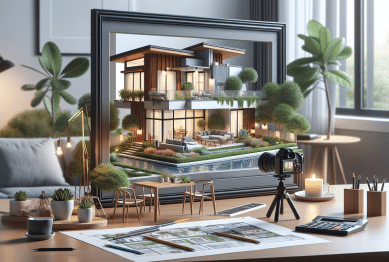Home staging plays a crucial role in how buyers perceive value in real estate. This guide explores common home staging tricks, how they impact what people actually spend, and the subtle signals influencing prices. Understand what professionals look for and how simple changes can shift the entire housing market.
What Is Home Staging and Why It Matters
Home staging is much more than making a property ‘look nice.’ It’s a strategic approach that uses interior design, lighting, and even scents to highlight a home’s best features. When a house is staged, it often feels inviting and well-kept—a feeling that can persuade buyers to see more value, resulting in higher sale prices or faster transactions. Many buyers never realize just how carefully their impressions are shaped by this process. Professionals in the real estate industry study buyer psychology, adjusting room layouts and decor to gently lead visitors’ eyes toward attributes the seller wishes to showcase. As a result, staged homes may be perceived as more desirable, even if their underlying features remain unchanged.
One of the most influential aspects of home staging is its ability to shift focus away from flaws. A small or outdated kitchen, for example, might be made less noticeable with bright colors, fresh fruit, and sophisticated countertop accessories. These subtle distractions allow visitors to remember the positives rather than dwell on areas in need of updates. Real estate agents frequently recommend professional staging to clients hoping to maximize their property’s market appeal. According to the National Association of Realtors, staged homes often spend less time on the market, underscoring how presentation shapes sales outcomes (https://www.nar.realtor/research-and-statistics/quick-real-estate-statistics).
People may wonder whether staging is only for luxury properties or high-end listings. In reality, the impact is seen across all price ranges and living spaces. Even vacant starter homes tend to perform better when staged compared with similarly priced, empty alternatives. Sometimes just rearranging existing furniture or adding pops of color can make a dramatic difference. This ultimately influences the perceived market value and has ripple effects on neighborhood pricing trends. Understanding the mechanisms behind these visual strategies helps buyers and sellers alike make more informed decisions when navigating the competitive real estate landscape.
The Science Behind Emotional Buying in Homes
Most decisions to buy a house are not entirely rational. Emotions play a leading role, and home staging is expertly designed to trigger them. Warm lighting, cozy seating arrangements, inviting aromas of baked goods—each element nudges visitors toward envisioning themselves living there. This emotional connection raises perceived value, influencing not just whether a buyer wants the property, but sometimes how much more they are willing to pay over asking price. Research by Harvard University found that subtle design elements such as natural light or plant placement can meaningfully shift a person’s impressions about a home’s liveability (https://www.gsd.harvard.edu/research).
Even digital home staging—where a home is virtually altered in photographs—creates a similar effect on online browsers. People tend to scroll past bare or cluttered rooms but linger over thoughtfully staged ones. In markets where competition is fierce, these emotional cues turn into measured advantages. Sellers often find that investments in professional staging translate not only to more showings, but also to stronger and faster offers. It’s common to see a staged property elicit bidding wars, which may set new benchmarks for neighborhood home values in the process.
On the buyer’s side, recognizing the effect of emotional triggers can be empowering. It’s easier to discern which responses are shaped by real quality improvements and which are more about presentation. While there’s no denying that a staged home can feel more welcoming, buyers might benefit from pausing to imagine the same space with their own furniture and style. Understanding emotional influence doesn’t have to detract from enjoyment—it simply helps all parties set more realistic expectations during the negotiation process.
Key Home Staging Techniques That Shift Perception
Stagers employ an array of techniques to make homes more appealing. Decluttering tops the list—removing excess personal items allows buyers to visualize their own life in the space. Neutral paint colors have become popular since they appeal to the biggest market segment and make rooms look brighter and larger. Strategic furniture placement is another powerful tool. By arranging seating to open up walkways or adding mirrors to bounce light, professionals create illusions of depth and comfort, even in smaller homes.
Lighting cannot be overstated. Stagers almost always maximize natural light and supplement with lamps or overhead fixtures to make spaces feel airy and inviting. Fresh linens and plush pillows are often added to bedrooms and living rooms to evoke a sense of tranquility. Simple outdoor staging—perhaps new mulch or seasonal flowers—can dramatically improve curb appeal, influencing a visitor’s attitude before even walking through the door. According to the U.S. Department of Housing and Urban Development, first impressions can have a profound impact on perceived property value (https://www.hud.gov/sites/documents/HSG-2012-09.PDF).
Even scents can play a part. The aroma of freshly baked cookies or subtle floral notes can stir memories of ‘home,’ prompting a feeling of belonging. Sometimes, stagers use faint essential oils or simply ensure all rooms are aired out to avoid any lingering odors. These techniques, while affordable and simple, are rooted in behavioral psychology and can leave a significant impact. Buyers and sellers alike benefit from understanding what’s beneath these seemingly small touches, as they ultimately affect the home’s perceived—and sometimes actual—market value.
Does Home Staging Really Affect Final Sale Prices?
The debate around home staging’s financial impact is ongoing, but multiple studies support the idea that well-staged homes generally sell faster and at higher prices compared to non-staged homes. Data gathered by the Real Estate Staging Association indicates staged properties can reduce average days on market by more than 30%, and frequently close at prices closer to or above initial listing. However, the effect can vary by location, market conditions, and staging quality.
Some skeptics believe the benefits of staging are overstated, especially in saturated or declining markets. Yet, when comparing homes of similar size, age, and amenities, staged homes almost always leave a stronger impression and are remembered longer by buyers. It’s not uncommon to see buyers offering several thousands more for a staged property simply because it feels ‘move-in ready.’ The National Association of Home Builders notes that perception of value is just as important as technical appraised value in influencing buyer behavior (https://www.nahb.org/news-and-economics/housing-economics/housing-data/top-10-features-home-buyers-want).
That said, staging is not a magic bullet. Homeowners hoping for a massive price increase from staging alone may need to temper expectations. Instead, the most notable benefits come from speeding up the sales timeline and maximizing offers in otherwise competitive or uncertain markets. For sellers already considering a price reduction, staging can be a cost-effective alternative to slashing the asking price—making it a strategic step that might help avoid larger financial concessions.
When Professional Home Staging Makes Most Sense
Professional home staging can offer the most advantages in particular situations. High-value homes and unique properties often benefit, since buyers in these categories expect a certain level of polish. Properties sitting vacant, or listed in slow or transitional markets, might also attract more buyers if staged to show potential. Even homes with challenging layouts can be dramatically improved through clever staging, highlighting strengths and minimizing potential dealbreakers.
For sellers on tighter budgets, it might make sense to hire a consultant for guidance and then complete much of the setup themselves. Many professional stagers offer partial or virtual services, reducing costs while still ensuring a professional look. The International Association of Home Staging Professionals notes that many successful agents incorporate staging into their standard process precisely because the cost often pays for itself in swifter, higher-value sales (https://www.iahsp.com).
Ultimately, the decision depends on market conditions and the goals of the seller. For those in hot markets, a bit of DIY staging might be sufficient to create interest. For others, a professionally staged home can make the needed difference to stand out among a sea of listings. Knowing the available options and likely results empowers both buyers and sellers to make more strategic moves in the real estate space.
Tips for Buyers: Seeing Beyond the Staged Surface
Understanding the role of staging allows buyers to approach open houses with a more discerning eye. Instead of being swept away by perfectly coordinated pillows or trendy artwork, pause to study the underlying features. Are high-traffic areas hidden under rugs? Does the furniture make rooms appear bigger than they are? Developing this awareness enables buyers to separate style from substance, resulting in more grounded decision-making.
It is helpful to imagine the home without the accessories or borrowed furniture. Ask for floor measurements and examine storage spaces behind closed doors. Natural light, ceiling height, and flow are harder to alter, so focus attention there. Awareness of home staging tricks does not spoil the appeal—it adds an extra layer of insight and often uncovers areas for negotiation. Savvy buyers use what they spot to ask pointed questions or even request price adjustments if staging clearly covers up needed repairs.
Finally, consider bringing along someone who has not seen the listing’s online images for a fresh perspective. Sometimes buyers miss things because they are primed by beautiful photographs. A trusted friend or consultant can provide balance. By going beyond face value, buyers not only protect their financial interests but also boost their confidence in what is one of life’s biggest investments.
References
1. National Association of Realtors. (n.d.). Quick Real Estate Statistics. Retrieved from https://www.nar.realtor/research-and-statistics/quick-real-estate-statistics
2. Harvard Graduate School of Design. (n.d.). Research. Retrieved from https://www.gsd.harvard.edu/research
3. U.S. Department of Housing and Urban Development. (2012). Housing Counseling: Hosting Effective Open Houses. Retrieved from https://www.hud.gov/sites/documents/HSG-2012-09.PDF
4. National Association of Home Builders. (n.d.). Top 10 Features Home Buyers Want. Retrieved from https://www.nahb.org/news-and-economics/housing-economics/housing-data/top-10-features-home-buyers-want
5. Real Estate Staging Association. (n.d.). The Benefits of Home Staging. Retrieved from https://www.realestatestagingassociation.com
6. International Association of Home Staging Professionals. (n.d.). Why Stage a Home? Retrieved from https://www.iahsp.com









